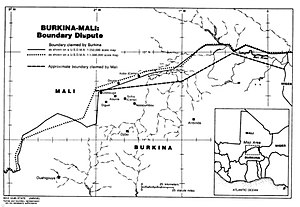
Back حرب قطاع أغاشير Arabic Guerra de la Franxa de Agacher AST Агашэрская вайна Byelorussian Válka o Agacher Czech Krieg um den Agacher-Streifen German Guerra de la Franja de Agacher Spanish Agacherin kaistaleen sota Finnish Guerre de la Bande d'Agacher French Perang Jalur Agacher ID Guerra della striscia di Agacher Italian
| Agacher Strip War | |||||||||
|---|---|---|---|---|---|---|---|---|---|
 United States Department of State map showing the competing claims of Mali and Burkina Faso in the Agacher Strip | |||||||||
| |||||||||
| Belligerents | |||||||||
|
|
| ||||||||
| Commanders and leaders | |||||||||
|
Moussa Traoré Bougary Sangaré Kokè Dembéle Kafougouna Koné Souleymane Daffé |
Thomas Sankara Blaise Compaoré | ||||||||
| Casualties and losses | |||||||||
|
~40 soldiers and civilians killed 2 soldiers captured |
100+ soldiers and civilians killed 16 soldiers captured | ||||||||
| History of Burkina Faso | ||||||||||||||||||
|---|---|---|---|---|---|---|---|---|---|---|---|---|---|---|---|---|---|---|
 | ||||||||||||||||||
|
||||||||||||||||||
|
||||||||||||||||||
The Agacher Strip War (French: Guerre de la Bande d’Agacher) or Christmas War (French: Guerre de Noël) was a war fought by Burkina Faso and Mali over a 160-kilometre-long (100 mi) strip of land along the border in northern Burkina Faso from 25 to 30 December 1985. The war ended in a ceasefire. The Agacher Strip had been subject to a border dispute between Mali and Burkina Faso since the 1960s. Following armed clashes in 1974, both countries agreed to mediation to resolve their differences. Progress on a solution stalled, and in 1983 Burkinabé President Thomas Sankara and Malian President Moussa Traoré decided to have the border dispute settled by the International Court of Justice and subsequently petitioned the body to resolve the issue.
In 1985, tensions rose between the Burkinabé and Malian governments as Sankara called for a revolution in Mali while Traoré's regime struggled to manage social unrest. After Burkinabé officials conducted a census in disputed border communities, Malian forces launched an offensive on 25 December with aircraft and tanks. Overwhelmed by Mali's superior firepower, Burkinabé forces lost control of the Agacher border communities and resorted to guerrilla tactics to stall Malian tanks. Mali subsequently occupied most of the Agacher Strip, while both countries conducted raids on each other's locales. A ceasefire was reached on 30 December, and in early 1986 successful mediation by West African countries resulted in an agreement from Sankara and Traoré to avoid further hostilities. The relatively poor performance of Burkina Faso during the war damaged the credibility of its revolutionary rulers and led them to project a more moderate international image. In Mali, the war added to the country's economic difficulties but boosted the popularity of Traoré's struggling regime. The International Court of Justice later ruled the Agacher Strip to be split among the two countries, a settlement which both accepted.